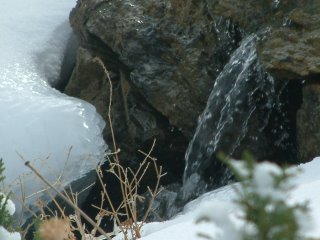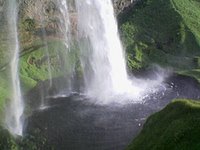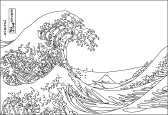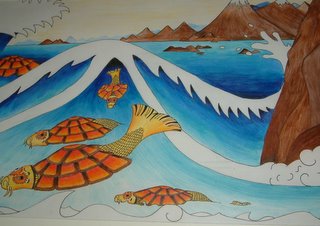Seven white wonders of the world
Small Swiss waterfall, white water, white ice 
 white sands, New Mexico
white sands, New Mexico
photo: whitewaves
White is so much more than a color. It is the one color that holds all the other colors in the world, and the longer we look at it the more we let one of its colors come through. Stare at a pristine snowflake and it becomes blue, gray, green, pink, depending on the light and objects around it.
Think of the seven white wonders of the world. Cold gives us snow and ice and frost. Waves thrown up and stirred about give us white water. Heat gives us sand. We have white pebble beaches and massive white rocks. These are ancient and modern world wonders.
We learn to see them as white, but they give us far more than visual experiences. The senses all go to work to teach us to "see" white.
White water and the nature of power
I grew up in a landlocked place, although the Mississippi River ran past us, fast and deep and opaquely muddy brown, so I never thought of myself as a water-deprived child. The year I was 12 the great river rushed out of its banks. We knew it would happen and we were let out of school to set out sandbags, piles of them, along the levee in downtown Davenport, Iowa. The girls made sandwiches, the boys shoveled sand, the men tossed the bags higher and higher and the women kept everyone organized.
That is how I remember it, but these are fuzzy images. The clear one is the shocking view of the department store. My mother had taken me there a week earlier to buy a pair of white shoes I saw in the big front windows. Later, my father held my hand as we stood at the edge of the still trembling Mississippi River, whose floodiness had just peaked. It covered the ground floor of Petersen Harned Von Maur, and the showcase windows were under water.
"evening thoughts"
photo: whitewaves
I could have been forgiven for thinking water was brown unless it came out of the tap, where it was clear. But I had seen differently three years earlier, when we visited an old Navy friend of my father, who had a home in Falmouth, Massachusetts, on Cape Cod. The lack of a shoreline on the other side of the visible ocean impressed me less than the churning white waves that crashed up on the beach one windy day.
Lapland photo: ginopongo
Water that suddenly drops because of a change in gradient, or that is forced into a narrower bed is usually white because it is aerated, with millionsof tiny bubbles forming.
Hokusai's famous wave painting 
Waves appear white when the wind transfers energy to the water, causing friction between air and water molecules.
We see ocean waves and waterfalls and river whitewater (the rafters' dream water) as white, usually against their darker surfaces of dense and rapidly moving water. We also feel their spray, taste the saltiness or feel the grittiness and hear the roar of white water.
Influenced by Hokusai
from painting by LR Bates
When I was little, smelling the sea air and watching the the white caps on the dark water come closer, I ran towards the magnificance of it all - and was shocked to learn that white water's embrace could have so much power that it would knock me down and fill my ears and nose with sand, and my hair with stickiness, for days after.
There is nothing simple about white.



0 Comments:
Post a Comment
<< Home